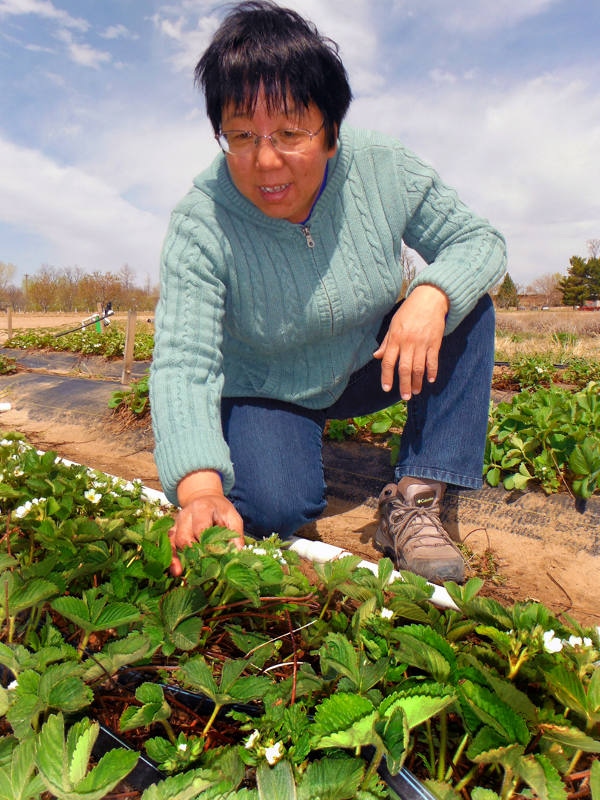May 9, 2013

Late freezes in Northern New Mexico damages fruit tree crops regularly. In 2011, the state's peach crop was lost to a late freeze. Growers are determining what impact the hard mid-April frost will have on this year's crop.
To provide research-based recommendations to fruit growers, New Mexico State University continues to test potential alternate fruit crops for Northern New Mexico.
Shengrui Yao, Cooperative Extension Service fruit specialist and researcher stationed at NMSU's Sustainable Agriculture Science Center at Alcalde, is studying strawberries to see if it could be a cash crop for the growers.
"Originally, I thought strawberries would be a wonderful crop because most of the time late frosts won't kill all of the flowers or buds in a cluster, so growers would always have some form of a crop," Yao said.
Yao decided to conduct variety trails to see if strawberries could survive a late freeze and to see which variety would adapt to the high pH soil and produce the best yield for the Northern New Mexico region. With support from USDA Specialty Crop Block Grant and the Agricultural Development and Promotion Fund from the New Mexico Department of Agriculture, she began the study in 2011.
"One reason we do a study over several years is to evaluate the crop in the different weather conditions that may occur," she said. "While our early buds were lost to the freeze this year, we will continue to see what type of yield does occur to let growers know what might be the results of a worst-case situation."
During the first year of the study in 2011, 16 varieties were planted and established in two treatments—plastic-covered system and natural beds-matted row system. The black plastic cover is used to suppress the weeds around the plants. The matted row system needs to be weeded several times during the first year after planting.
"Strawberry plants send out runners where clusters of leaves and blossoms form at regular interval," Yao said. "This allows the strawberry bed to expand and provide more berries."
In the plastic-covered beds, the plants also send out runners but there is no room for the runners to root. The runners have to be removed manually. Plants in the plastic system rely on the branched crowns to produce fruit, which grow taller and taller each year. The plants that were in the matted row system had a better winter survival since the crowns of the plants were close to the ground.
"With the cold January this year, the strawberry plants with plastic cover had bad winter damage," Yao said. "But we were able to determine that Kent, Mesabi, Cavendish, Honeoye, Brunswick and Cabot were hardy cultivars."
Wendy, Chandler, Clancy and Allstar had the worst winter damage with some dead crowns in the plants.
Additionally, the study is designed to determine which treatment will help strawberry plants adapt to high pH soil that is the normal condition of Northern New Mexico.
"We want to see which cultivars are more tolerant to the high pH soil by measuring the relative chlorophyll content in the leaves," Yao said.
Tolerant cultivars
The six most tolerant cultivars to date are Wendy, Brunswick, Jewel, Cavendish and Honeoye. The most sensitive cultivars are Allstar, Chandler and Darselect.
A common problem for high pH soil is iron deficiency in plants even when the soil iron level is not low.
"We are managing the leaf chlorosis caused by the iron deficiency with a chelated iron supplement applied through the drip irrigation system," Yao said. "We we are using a product called FerriPlus which is effective in correcting leaf chlorosis."
Two other issues Yao faced during the first two years of the study were tarnished plant bugs and anthracnose disease.
"In general, disease is not a big issue in strawberry production in New Mexico. However, we did have anthracnose, a fungal disease, in the plot in 2012," she said.
"What we did learn in 2012 is that Earliglow, Allstar, Jewel, Darselect and Honeoye were sensitive cultivars to the disease, while Brunswick, Cavendish and Mesabi were more tolerant to anthracnose."
The impact of tarnished plant bug is that the fruit does not form to an ideal shape. The eggs are deposited on the fruit, and when the larvae hatch, they suck on the fruit causing it to be malformed.
"Because the strawberry field was near an alfalfa plot, which is another host for tarnished plant bugs, we had an issue with these bugs," Yao said. "A little bug, a fourth-of-an-inch in size, can do huge damage to the crop."
Yao wants to conduct the study for several years to obtain yield information from the various seasonal conditions and observe possible problems associated with each planting system.
After two years, the three most productive cultivars were Mesabi, Cavendish and Kent, while the three least productive were Earliglow, Wendy and Chandler.
"Cultivar recommendation should not be based on one characteristic, but all in general," she said. "I would prefer to have another good harvest and then make cultivar recommendations."
With that said, the Mesabi cultivar is leading the study after the first two years.
"Mesabi has its special genetic June yellow leaves, but has a good winter hardiness, yield and disease resistance," she said. "It might not be a bad one to be raised in this region."
You may also like:
Celebrating specialty crops, Strawberry Fest attracts huge crowds
You May Also Like




